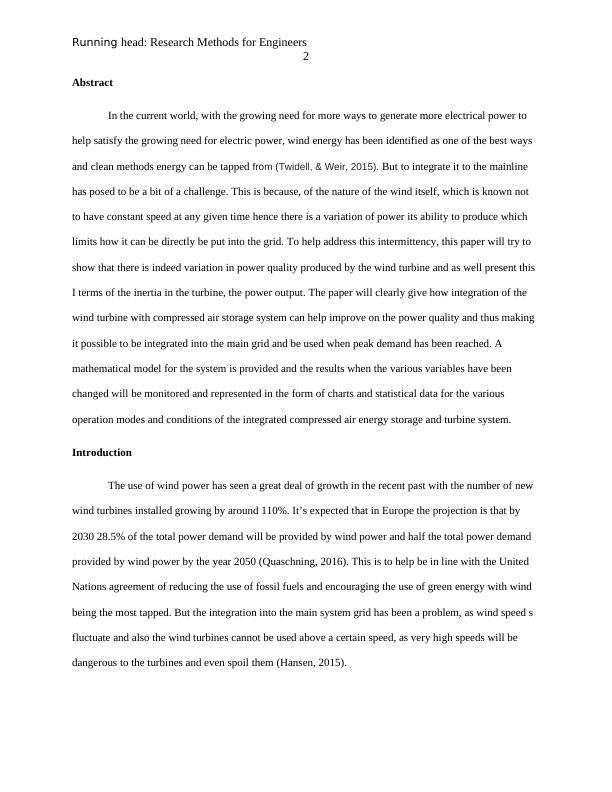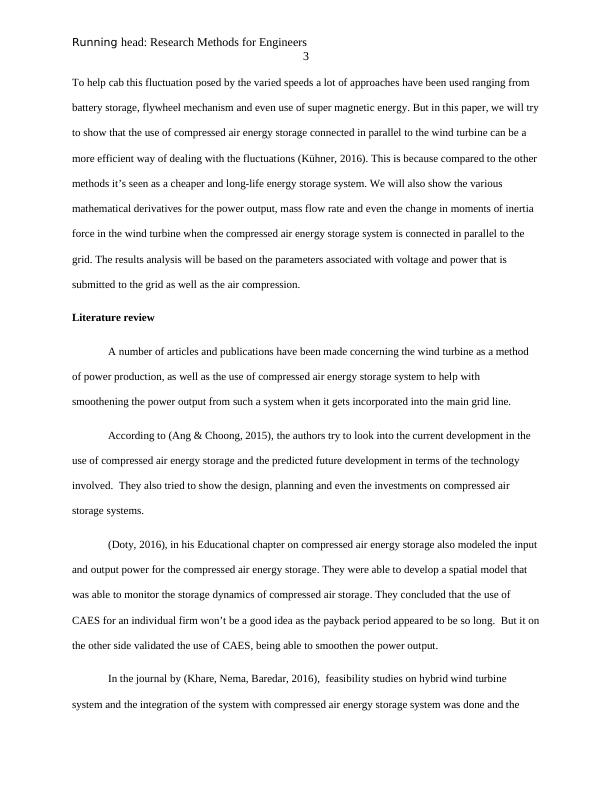Improving Power Grid Performance with Compressed Air Energy Storage and Wind Turbine System
Added on 2022-12-15
8 Pages1614 Words371 Views
Running head: Research Methods for Engineers
1
Improving power grid performance using parallel connected
Compressed Air Energy Storage and wind turbine system
Student’s Name
Institutional Affiliation
1
Improving power grid performance using parallel connected
Compressed Air Energy Storage and wind turbine system
Student’s Name
Institutional Affiliation

Running head: Research Methods for Engineers
2
Abstract
In the current world, with the growing need for more ways to generate more electrical power to
help satisfy the growing need for electric power, wind energy has been identified as one of the best ways
and clean methods energy can be tapped from (Twidell, & Weir, 2015). But to integrate it to the mainline
has posed to be a bit of a challenge. This is because, of the nature of the wind itself, which is known not
to have constant speed at any given time hence there is a variation of power its ability to produce which
limits how it can be directly be put into the grid. To help address this intermittency, this paper will try to
show that there is indeed variation in power quality produced by the wind turbine and as well present this
I terms of the inertia in the turbine, the power output. The paper will clearly give how integration of the
wind turbine with compressed air storage system can help improve on the power quality and thus making
it possible to be integrated into the main grid and be used when peak demand has been reached. A
mathematical model for the system is provided and the results when the various variables have been
changed will be monitored and represented in the form of charts and statistical data for the various
operation modes and conditions of the integrated compressed air energy storage and turbine system.
Introduction
The use of wind power has seen a great deal of growth in the recent past with the number of new
wind turbines installed growing by around 110%. It’s expected that in Europe the projection is that by
2030 28.5% of the total power demand will be provided by wind power and half the total power demand
provided by wind power by the year 2050 (Quaschning, 2016). This is to help be in line with the United
Nations agreement of reducing the use of fossil fuels and encouraging the use of green energy with wind
being the most tapped. But the integration into the main system grid has been a problem, as wind speed s
fluctuate and also the wind turbines cannot be used above a certain speed, as very high speeds will be
dangerous to the turbines and even spoil them (Hansen, 2015).
2
Abstract
In the current world, with the growing need for more ways to generate more electrical power to
help satisfy the growing need for electric power, wind energy has been identified as one of the best ways
and clean methods energy can be tapped from (Twidell, & Weir, 2015). But to integrate it to the mainline
has posed to be a bit of a challenge. This is because, of the nature of the wind itself, which is known not
to have constant speed at any given time hence there is a variation of power its ability to produce which
limits how it can be directly be put into the grid. To help address this intermittency, this paper will try to
show that there is indeed variation in power quality produced by the wind turbine and as well present this
I terms of the inertia in the turbine, the power output. The paper will clearly give how integration of the
wind turbine with compressed air storage system can help improve on the power quality and thus making
it possible to be integrated into the main grid and be used when peak demand has been reached. A
mathematical model for the system is provided and the results when the various variables have been
changed will be monitored and represented in the form of charts and statistical data for the various
operation modes and conditions of the integrated compressed air energy storage and turbine system.
Introduction
The use of wind power has seen a great deal of growth in the recent past with the number of new
wind turbines installed growing by around 110%. It’s expected that in Europe the projection is that by
2030 28.5% of the total power demand will be provided by wind power and half the total power demand
provided by wind power by the year 2050 (Quaschning, 2016). This is to help be in line with the United
Nations agreement of reducing the use of fossil fuels and encouraging the use of green energy with wind
being the most tapped. But the integration into the main system grid has been a problem, as wind speed s
fluctuate and also the wind turbines cannot be used above a certain speed, as very high speeds will be
dangerous to the turbines and even spoil them (Hansen, 2015).

Running head: Research Methods for Engineers
3
To help cab this fluctuation posed by the varied speeds a lot of approaches have been used ranging from
battery storage, flywheel mechanism and even use of super magnetic energy. But in this paper, we will try
to show that the use of compressed air energy storage connected in parallel to the wind turbine can be a
more efficient way of dealing with the fluctuations (Kühner, 2016). This is because compared to the other
methods it’s seen as a cheaper and long-life energy storage system. We will also show the various
mathematical derivatives for the power output, mass flow rate and even the change in moments of inertia
force in the wind turbine when the compressed air energy storage system is connected in parallel to the
grid. The results analysis will be based on the parameters associated with voltage and power that is
submitted to the grid as well as the air compression.
Literature review
A number of articles and publications have been made concerning the wind turbine as a method
of power production, as well as the use of compressed air energy storage system to help with
smoothening the power output from such a system when it gets incorporated into the main grid line.
According to (Ang & Choong, 2015), the authors try to look into the current development in the
use of compressed air energy storage and the predicted future development in terms of the technology
involved. They also tried to show the design, planning and even the investments on compressed air
storage systems.
(Doty, 2016), in his Educational chapter on compressed air energy storage also modeled the input
and output power for the compressed air energy storage. They were able to develop a spatial model that
was able to monitor the storage dynamics of compressed air storage. They concluded that the use of
CAES for an individual firm won’t be a good idea as the payback period appeared to be so long. But it on
the other side validated the use of CAES, being able to smoothen the power output.
In the journal by (Khare, Nema, Baredar, 2016), feasibility studies on hybrid wind turbine
system and the integration of the system with compressed air energy storage system was done and the
3
To help cab this fluctuation posed by the varied speeds a lot of approaches have been used ranging from
battery storage, flywheel mechanism and even use of super magnetic energy. But in this paper, we will try
to show that the use of compressed air energy storage connected in parallel to the wind turbine can be a
more efficient way of dealing with the fluctuations (Kühner, 2016). This is because compared to the other
methods it’s seen as a cheaper and long-life energy storage system. We will also show the various
mathematical derivatives for the power output, mass flow rate and even the change in moments of inertia
force in the wind turbine when the compressed air energy storage system is connected in parallel to the
grid. The results analysis will be based on the parameters associated with voltage and power that is
submitted to the grid as well as the air compression.
Literature review
A number of articles and publications have been made concerning the wind turbine as a method
of power production, as well as the use of compressed air energy storage system to help with
smoothening the power output from such a system when it gets incorporated into the main grid line.
According to (Ang & Choong, 2015), the authors try to look into the current development in the
use of compressed air energy storage and the predicted future development in terms of the technology
involved. They also tried to show the design, planning and even the investments on compressed air
storage systems.
(Doty, 2016), in his Educational chapter on compressed air energy storage also modeled the input
and output power for the compressed air energy storage. They were able to develop a spatial model that
was able to monitor the storage dynamics of compressed air storage. They concluded that the use of
CAES for an individual firm won’t be a good idea as the payback period appeared to be so long. But it on
the other side validated the use of CAES, being able to smoothen the power output.
In the journal by (Khare, Nema, Baredar, 2016), feasibility studies on hybrid wind turbine
system and the integration of the system with compressed air energy storage system was done and the

End of preview
Want to access all the pages? Upload your documents or become a member.
Related Documents
Assignment On Renewable Sources Of Energylg...
|6
|2594
|21
Microgrid Designlg...
|17
|4351
|242
Field Grid-Based Energy Storage Systemslg...
|14
|3520
|202
DESIGN OF PUMPED HYDROELECTRIC ENERGY STORAGE SYSTEM PROJECT 2022lg...
|10
|2804
|21
Wind Turbines Induction Generators (Doc)lg...
|14
|2434
|679
Energy Storage: Principles, Advantages, and Design of Flywheel and Compressed Air Systemslg...
|15
|4214
|371
